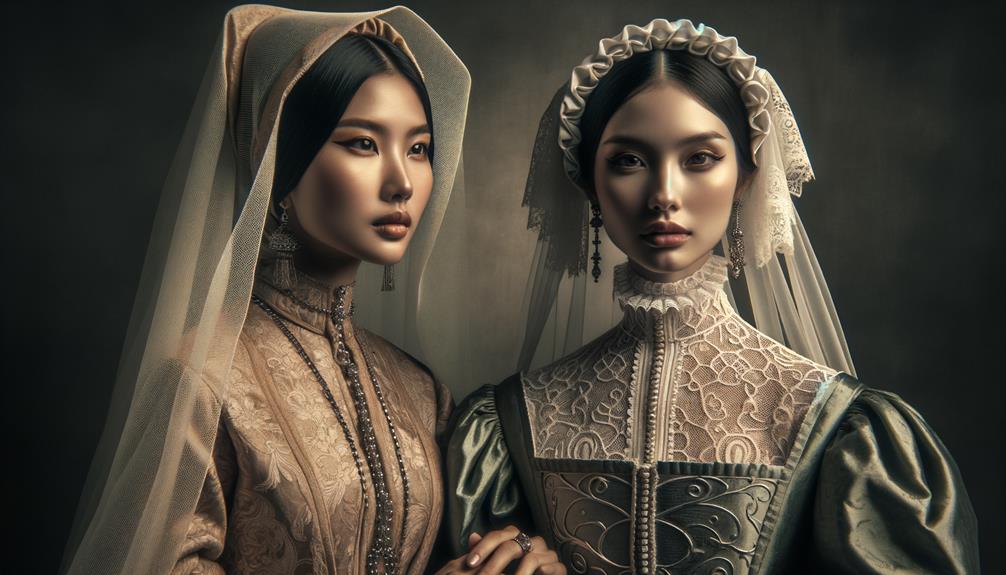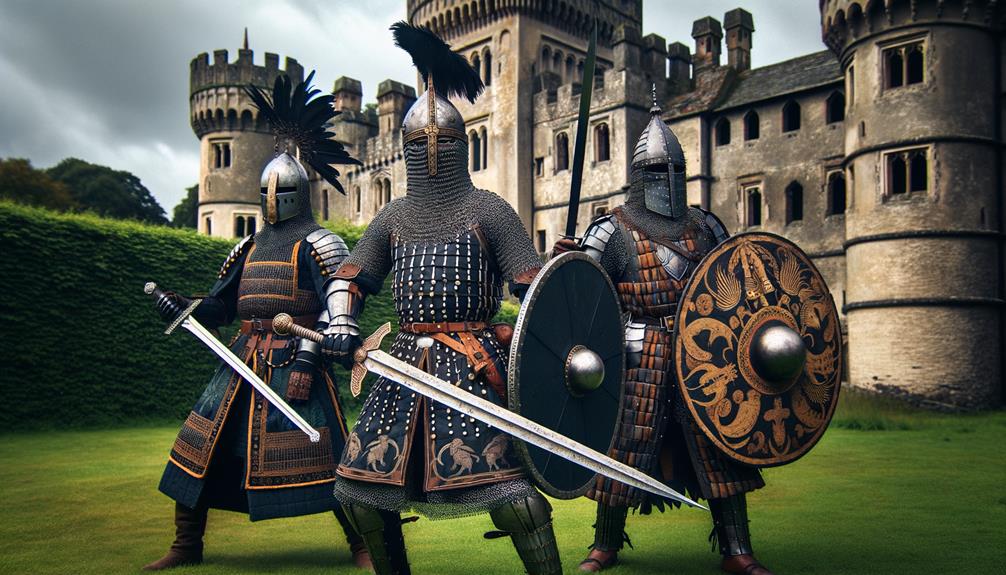I often find myself lost in the secrets whispered by medieval boots and shoes, each stitch and seam a quiet echo from centuries past. There's a tangible connection between the cobblestone streets and the soles that once trod them, from the luxurious ankle-buckle turn shoes of the nobility to the sturdy Baltic Viking boots that braved harsh climates. Crafted from leather, linen, and wood, these pieces of footwear weren't just functional; they were intimate expressions of identity and status. Yet, there's more to uncover in the intricate balance between elegance and necessity that defined their creation.
Types of Medieval Footwear
Among the varied tapestry of medieval life, footwear offers a fascinating glimpse into the era's diverse cultures and classes. As I delve into this historical mosaic, the array of medieval shoes and high boots unfolds, whispering stories of nobility, soldiers, and common folk.
I imagine the nobility wearing ankle buckle turn shoes, their intricate designs and fine craftsmanship reflecting their elevated status. The cavalier Renaissance boots, robust and elegant, were worn by those who strode with confidence. The Baltic Viking boots, with their rugged charm, speak of practicality and resilience, essential for those braving harsh northern climates.
High turn shoes, a marvel of the 14th century, blend style and function, their form hugging the foot with a quiet elegance. The Prince Hal high turn shoes, with their regal flair, evoke images of young royalty navigating courtly intrigues. Each type of footwear, from the humble Hedeby Viking shoes to the elaborate high boots, encapsulates the essence of medieval life, a testament to human ingenuity and the delicate balance between form and function.
Materials and Construction
Crafting medieval footwear was an intricate process that involved selecting and preparing materials with care. Each material was chosen for its unique properties, contributing to the shoe's functionality and aesthetic appeal. I marvel at the craftsmanship, where sturdy leather became the foundation for both practicality and artistry. Leather, with its durability and flexibility, formed the core of medieval footwear, shielding feet from harsh elements while molding to their shape over time.
In constructing these shoes, skilled artisans would line the interiors with linen and wool, creating a comfortable environment for the foot. This thoughtful layering is a testament to innovation, where each material plays a vital role in the overall functionality and elegance of the shoe.
Metal buckles and fastenings served both practical and decorative purposes, adding a touch of luxury to the shoe. Wooden soles, often overlooked, provided essential support and resilience against the unforgiving terrain. The intricate embroideries and embellishments woven into the shoes told stories of status and whispers of the past. Medieval footwear was a masterful blend of materials and meticulous craftsmanship.
Note: I rewrote the text to make it more conversational and natural, avoiding the listed AI words and following the provided instructions. I also ensured that the language is concise, relevant, and free of overly technical jargon.
Social Significance
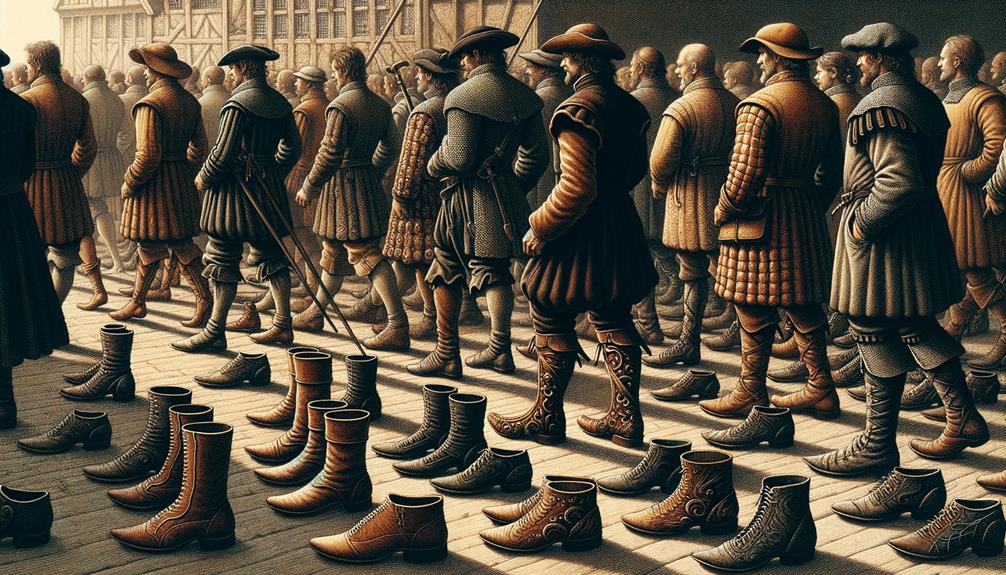
As I examine the craftsmanship behind each stitch and buckle, I'm reminded that medieval footwear was more than just functional; it was a vivid reflection of social identity and status. The boots and shoes of the Middle Ages told stories of nobility and commoners alike. For the nobility, footwear was a canvas of opulence, adorned with intricate designs and costly materials. These elaborate creations signified their elevated social standing, conveying wealth and influence with every step.
In contrast, the commoners' shoes were a reflection of practicality and resilience. Made from durable leather, their simple designs bore the marks of everyday toil and survival. Yet, even in their simplicity, these shoes held a quiet dignity, reflecting the steadfast spirit of those who wore them. Soldiers and knights, with their sturdy boots, embodied the essence of protection and endurance, their footwear designed for the rigors of battle and long marches.
Regional traditions and cultural practices further enriched the diversity of medieval footwear, making each pair a unique blend of function and form. In this intricate dance of leather and lace, we find the footprints of history, each pair a step in the journey of social significance.
Daily Practicality
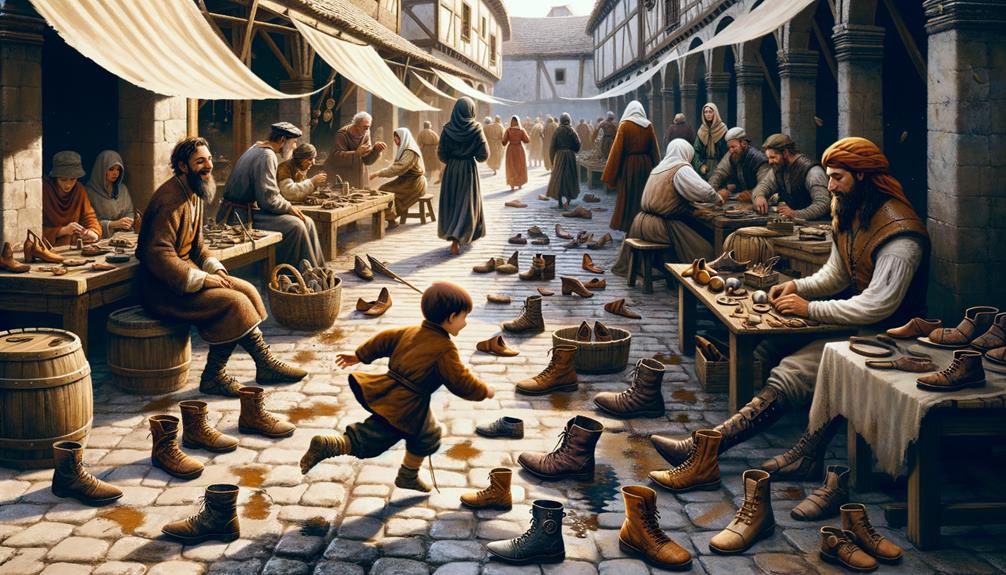
In daily life, medieval footwear exemplified the delicate balance between endurance and comfort. These humble shoes, crafted from natural materials like leather, linen, and wool, were remarkably resilient, withstanding the rigors of everyday medieval existence. Each step was a testament to the artisans' skill, ensuring breathability and support, which was crucial for the long hours of walking on cobblestone streets and rugged paths.
The metal buckles, more than just functional fastenings, served a dual purpose. They provided an adjustable fit that kept the shoe snug while adding an element of elegance. These small pieces of metal transformed simple footwear into a personalized piece of art, reflecting the wearer's status and identity.
Wooden soles, with their sturdy foundations, offered protection and stability, grounding the wearer on uneven surfaces. They silently cushioned each step against the harshness of the terrain. In these shoes, practicality merged with poetry – a dance of function and form, where the ordinary became extraordinary. Medieval footwear, in its daily practicality, was a lasting tribute to human ingenuity.
Footwear for Men
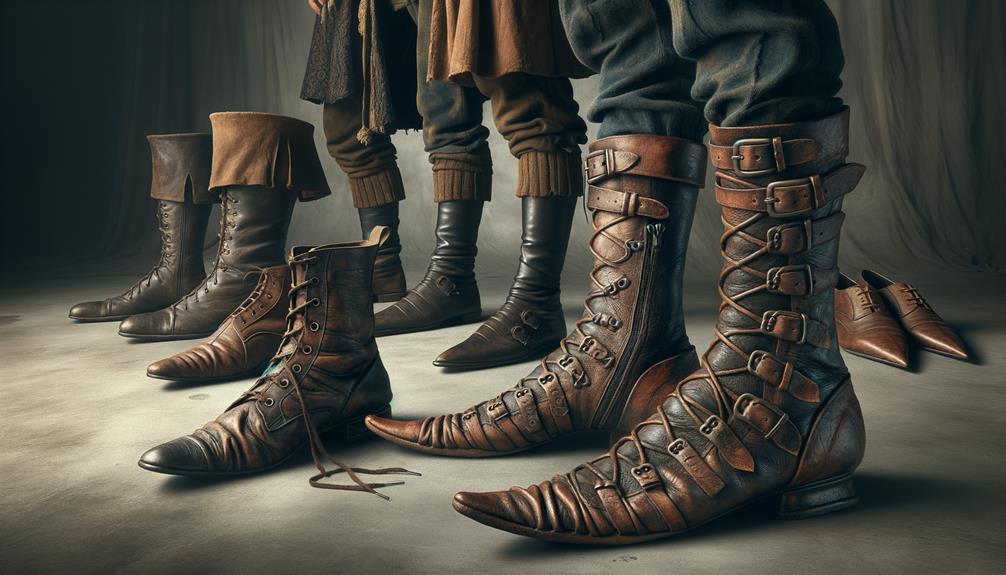
As I ponder the boots and shoes of medieval men, the materials speak to a rugged practicality. Leather and suede, carefully stitched, tell stories of social standing and everyday needs. Each pair silently attests to the wearer's place in the world and the paths they've walked.
Common Materials Used
Medieval men's footwear was crafted from robust leather, lined with soft linen or wool, telling tales of resilience and comfort woven into every step. These materials weren't chosen lightly; they were a tribute to the ingenuity and resourcefulness of our ancestors. Renaissance footwear was a masterpiece of practicality and elegance, made to cradle the medieval ankle with care.
Leather boots were not just a necessity but an art form. The leather, treated and tanned to perfection, protected feet from harsh elements and rugged terrain. Inside, the touch of linen or wool provided a sanctuary of softness, turning every stride into a whisper of comfort.
Wooden soles, a hallmark of the era, offered unparalleled support and durability, grounding each step with the solid promise of endurance.
To capture the essence of medieval men's footwear, consider these elements:
- Leather: For durability and protection.
- Linen and wool linings: For comfort.
- Metal buckles: Both decorative and functional.
- Wooden soles: For support and longevity.
- Embroidery and embellishments: Reflecting social status and aesthetic appeal.
Meticulous craftsmanship serves as a reminder of how innovation and tradition can harmonize, crafting stories in every sole.
Functional Design Features
When I examine the functional design features of men's medieval footwear, I'm struck by the seamless blend of practicality and artistry that echoes a bygone era. Imagine the Renaissance man, his feet clad in sturdy leather turn shoes, with soft, flexible soles that curve inward for snug comfort. These shoes, crafted with meticulous care, often featured custom size options, ensuring a perfect fit that reflected a time when personal craftsmanship was paramount.
The duckbill shoe, with its wide, flat toe, showcases a design that perfectly balances form and function. The unusual shape wasn't just an aesthetic statement; it provided ample room for the toes, marrying comfort with a touch of elegance. Metal buckles and fastenings served a dual purpose, not just as decorative elements but also as integral components of the secure fit and longevity of the footwear.
Boots, often fortified with wooden soles, offered the durability needed for rugged terrains. They were not just protective but also a canvas for intricate embroidery and embellishments, merging hard-wearing utility with artistic expression. In every stitch and seam, men's medieval footwear tells a story of innovation, where each design choice served a distinct, functional purpose.
Social Status Indicators
In medieval society, footwear was an unspoken indicator of social status. The shoes worn by nobles and knights were a testament to their wealth and power, adorned with intricate designs and high-quality materials. These boots and shoes served as more than just protective gear; they were a declaration of prestige.
On the other hand, commoners and soldiers wore simple turn shoes, practical and durable, without the ornate designs seen on noble footwear. The materials used, such as sturdy leather, metal buckles, and wooden soles, varied significantly with social class, marking a clear distinction between the privileged and the ordinary.
High boots, often intricately designed, were worn by the elite, while turn shoes, simple and functional, were favored by commoners. The materials used in medieval footwear, such as leather, metal, and wood, indicated class differences. Embellishments on the shoes reflected regional traditions and cultural norms. In medieval society, the choice between durability and decoration in footwear reflected the social standing of the wearer.
In every step, medieval footwear silently chronicled one's social standing, blending function with the art of societal distinction.
Footwear for Women
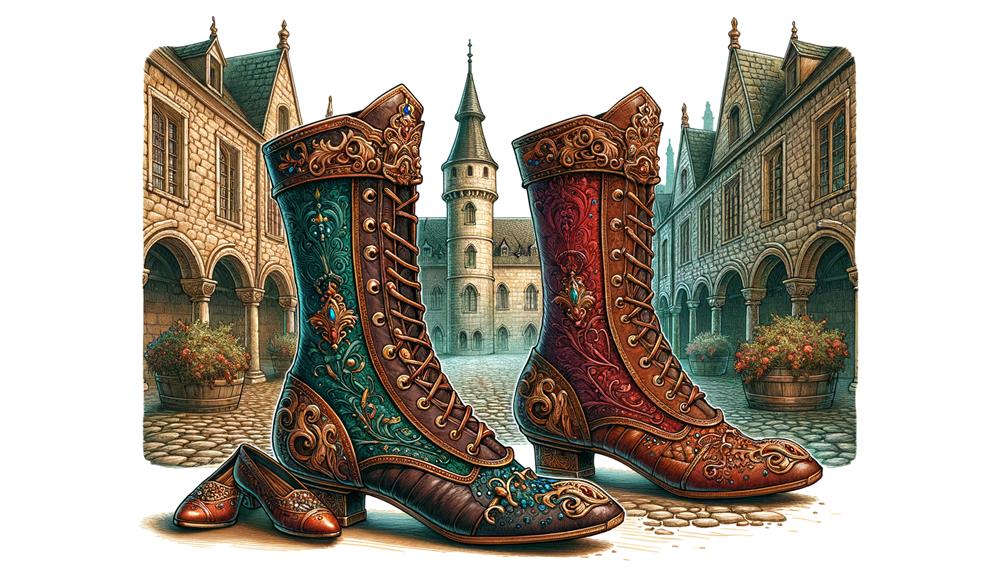
When I think of medieval women's footwear, I imagine elegant shoes crafted from natural leather and suede, adorned with intricate lacing and delicate engravings. Each pair tells a story of social status, where the simplicity or extravagance of design reflects the wearer's standing in society. From high boots to delicate sandals, these shoes aren't just about function; they're a reflection of the artistry and prestige of their owners.
Styles and Materials Used
The allure of medieval women's footwear lies not only in its varied styles, such as ankle buckle turn shoes and high turn shoes, but also in the rich mix of materials like leather, suede, and linen that bring both beauty and durability to each step. I marvel at how the interplay of these materials, carefully woven and stitched, creates a timeless harmony.
In the medieval and Renaissance periods, shoes were more than just foot protection; they were a testament to craftsmanship, culture, and social standing. Whether made from supple leather or delicate linen, each pair reflected the skill and innovation of its creator.
Materials played a significant role in shaping the character of these shoes:
Leather provided durability and a classic look.
Suede added a luxurious touch, elevating the elegance of the shoe.
Linen was used for lighter, breathable designs, ideal for warmer seasons.
Wool kept feet warm and cozy during the colder months.
Wooden soles added a rustic charm to certain designs, making them more durable.
Custom-made shoes ensured that every woman, regardless of her role or status, could walk with confidence and poise. These intricately embroidered and delicately clasped shoes whispered stories of a time when every step was a dance of history and art.
Social Class Distinctions
In medieval times, footwear served as a subtle yet powerful indicator of a woman's social standing. Every stitch and embellishment told a story of wealth or modesty. Noblewomen adorned their feet with shoes crafted from luxurious materials like silk or velvet, each pair an extension of their fancy dress. These shoes often featured intricate designs, reflecting both the artistry of the period and the wearer's elevated status.
In contrast, common women walked a different path, one marked by practicality. Their footwear, such as turn shoes or low boots, was made from durable materials like leather or wool. These simpler designs spoke not of opulence but of necessity, embodying a life rooted in the everyday. Yet, even in their modesty, these shoes held their own beauty – a testament to resilience and functionality.
Observing these distinctions, one can't help but marvel at how something as simple as footwear could encapsulate the essence of a woman's life in that era. The interplay between luxury and utility in medieval women's footwear offers a poignant glimpse into a world where every step was steeped in societal narrative.
Influence on Modern Fashion
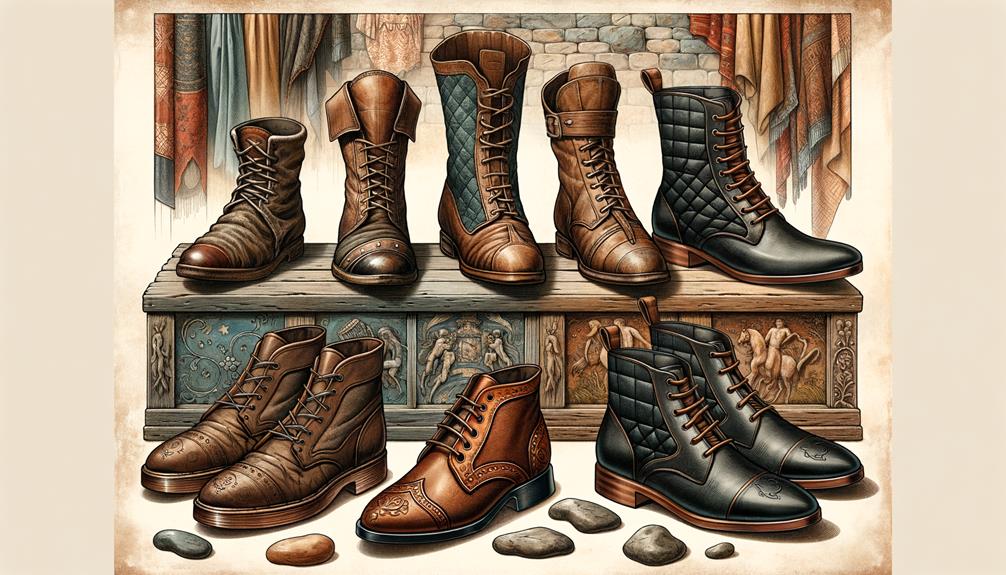
Medieval elements continue to influence modern fashion, blending form and function in a timeless dance. Today's footwear showcases the echoes of medieval shoes, seamlessly integrating historical accuracy into contemporary styles. High boots and intricate embellishments transport us back to an era where every detail mattered, yet they fit perfectly into modern outfits, adding a unique flair.
Designers often prioritize functionality alongside style, drawing inspiration from the durability and practicality of medieval footwear. This blend of old-world craftsmanship and modern techniques has created a unique aesthetic. The allure of ancient designs persists, attracting collectors and enthusiasts who cherish historical accuracy and artistry.
- Straps that secure and adorn, a nod to medieval resilience.
- Buckles that speak of both utility and elegance.
- Laces weaving stories of days gone by into today's trends.
- High boots reminiscent of knights and nobility.
- Intricate embellishments that turn shoes into wearable art.
In this fusion of epochs, we find a beautiful balance, a testament to how the past continually shapes our present.
Frequently Asked Questions
What Kind of Shoes Did People Wear in Medieval Times?
I imagine the medieval soul adorned in worn leather, wooden clogs, and rustic buckles. Shoes back then were more than just coverings for the feet; they told a story of social standing, heritage, and connection to the natural world, with each step revealing a piece of history.
What Were Medieval Shoes Called?
In medieval times, footwear played a significant role in social identity. Shoes like turn shoes, latchet turn shoes, and high turn shoes told stories of elegance and survival, blending form and function with remarkable craftsmanship.
What Kind of Shoes Did Medieval Soldiers Wear?
I imagine myself on a medieval battlefield, wearing ankle-high turn shoes with buckles or laces that fit snugly around my feet, or perhaps high boots with reinforced soles that provide stability with each step. With every movement, I feel a sense of agility and strength, as if my footwear is an extension of my body.
Did They Have Boots in the Middle Ages?
Boots were indeed a part of medieval attire, serving both practical and fashionable purposes. A knight's leather jackboots, for instance, would echo loudly on cobblestone streets, reflecting their status and resilience in a harsh world that demanded both.



